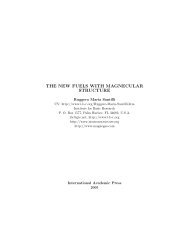hadronic mathematics, mechanics and chemistry - Institute for Basic ...
hadronic mathematics, mechanics and chemistry - Institute for Basic ...
hadronic mathematics, mechanics and chemistry - Institute for Basic ...
Create successful ePaper yourself
Turn your PDF publications into a flip-book with our unique Google optimized e-Paper software.
HADRONIC MATHEMATICS, MECHANICS AND CHEMISTRY 21<br />
systems predict the existence of new clean energies <strong>and</strong> fuels that are prohibited<br />
by the spacetime symmetries of the exterior systems.<br />
As we shall see in Section 1.2.7, Chapter 6 <strong>and</strong> Chapter 12, the assumption that<br />
the undetectable quarks are physical constituents of hadrons prohibits possible<br />
new energy based on processes occurring in the interior of hadrons (rather than<br />
in the interior of their ensembles such as nuclei). On the contrary, the assumption<br />
of <strong>hadronic</strong> constituents that can be fully defined in our spacetime <strong>and</strong> can be<br />
produced free under suitable conditions, directly implies new clean energies.<br />
1.2.7 The Scientific Imbalance Caused by Quark<br />
Conjectures<br />
One of the most important objectives of this monograph, culminating in the<br />
presentation of Chapter 12, is to show that the conjecture that quarks are physical<br />
particles existing in our spacetime constitutes one of the biggest threats to<br />
mankind because it prevents the orderly scientific process of resolving increasingly<br />
cataclysmic environmental problems.<br />
It should be clarified in this respect, as repeatedly stated by the author in his<br />
writings that the unitary, Mendeleev-type, SU(3)-color classification of hadron<br />
into families can be reasonably considered as having a final character (see e.g.,<br />
Ref. [99] <strong>and</strong> papers quoted therein), in view of the historical capability of said<br />
classification to predict several new particles whose existence was subsequently<br />
verified experimentally. All doubts herein considered solely refer to the joint use<br />
of the same classification models as providing the structure of each individual<br />
element of a given <strong>hadronic</strong> family (<strong>for</strong> more details, see memoirs [100,101] <strong>and</strong><br />
preprint [102] <strong>and</strong> Chapter 6).<br />
Far from being alone, this author has repeatedly expressed the view that quarks<br />
cannot be physical constituents of hadrons existing in our spacetime <strong>for</strong> numerous<br />
independent reasons.<br />
On historical grounds, the study of nuclei, atoms <strong>and</strong> molecules required two<br />
different models, one <strong>for</strong> the classification <strong>and</strong> a separate one <strong>for</strong> the structure<br />
of the individual elements of a given SU(3)-color family. Quark theories depart<br />
from this historical teaching because of their conception to represent with one<br />
single theory both the classification <strong>and</strong> the structure of hadrons.<br />
As an example, the idea that the Mendeleev classification of atoms could jointly<br />
provide the structure of each individual atom of a given valence family is outside<br />
the boundary of science. The Mendeleev classification was essentially achieved<br />
via classical theories, while the underst<strong>and</strong>ing of the atomic structure required<br />
the construction of a new theory, quantum <strong>mechanics</strong>.<br />
Independently from the above dichotomy classification vs structure, it is well<br />
known by specialists, but rarely admitted, that quarks are purely mathematical<br />
quantities, being purely mathematical representations of a purely mathematical














